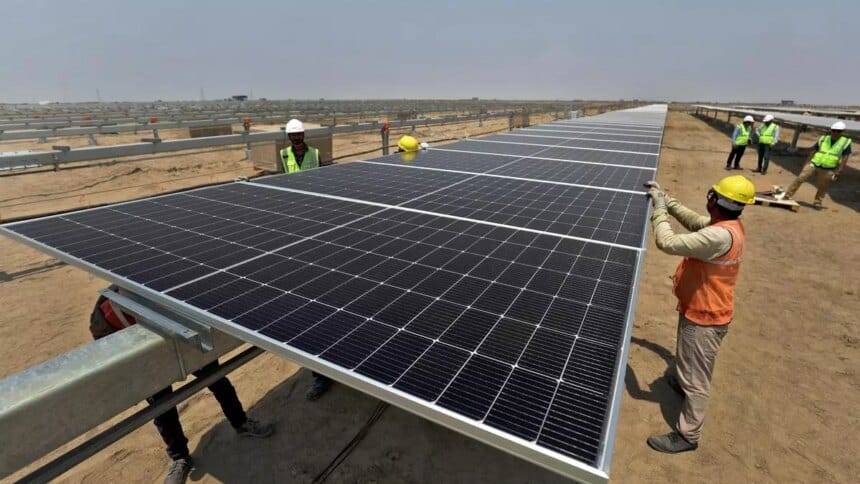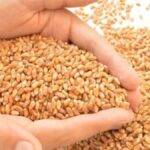Main Points In Hindi (मुख्य बातें – हिंदी में)
-
सौर ऊर्जा का योगदान: भारत 2030 तक 500 गीगावॉट नवीकरणीय ऊर्जा उत्पादन लक्ष्य की ओर बढ़ रहा है, जिसमें सौर ऊर्जा एक महत्वपूर्ण भूमिका निभाने की उम्मीद है। हालांकि, सौर ऊर्जा के लिए भूमि की आवश्यकता कृषि के साथ प्रतिस्पर्धा का कारण बन सकती है।
-
एग्रीवोल्टिक्स का विकास: पीएम-कुसुम योजना के तहत, सौर ऊर्जा को खेती के साथ एकीकृत करने के लिए एग्रीवोल्टिक्स तकनीक का प्रोत्साहन दिया जा रहा है, जहाँ सौर पैनलों के नीचे फसलों की खेती की जा सकती है। यह उत्पादन क्षमता बढ़ाने और ऊर्जा खपत को कम करने में सहायक है।
-
अतिरिक्त आय का अवसर: सौर फार्मों से प्रति एकड़ लीज किराया कृषि आय को बढ़ाने में योगदान कर सकता है। भारत में वर्तमान कृषि आय में विविधता है, और सौर ऊर्जा से अतिरिक्त आय किसानों की आय को दोगुना करने में मदद कर सकती है।
-
सतत विकास: सौर ऊर्जा और कृषि के संयोजन से न केवल आर्थिक लाभ होगा, बल्कि यह पर्यावरण संरक्षण में भी योगदान देगा। प्राचीन भारतीय मान्यताओं के अनुसार, कृषि और सूर्य दोनों की पूजा की जाती है, जिससे इस सहजीवी संबंध की प्रासंगिकता और भी बढ़ जाती है।
- चुनौतियाँ और संभावनाएँ: भारत में सौर ऊर्जा की संभावनाएँ व्यापक हैं, लेकिन किसानों की भागीदारी और निजी पूंजी की भूमिका को समझने की आवश्यकता है ताकि इन समाधानों को अपनाने में किसी भी झिझक को कम किया जा सके।
Main Points In English(मुख्य बातें – अंग्रेज़ी में)
Here are the main points highlighted in the article regarding the integration of solar energy and agriculture in India:
-
Renewable Energy Goals: India aims to achieve a renewable energy production capacity of 500 gigawatts by 2030, with solar energy expected to play a significant role. However, the land requirement for solar energy (3.5 acres per megawatt) may lead to competition with agricultural land.
-
Agri-Voltaics Initiative: The PM-KUSUM scheme promotes the integration of solar energy in agriculture by encouraging solar project installations on barren land and agro-voltaic systems, where crops can be cultivated beneath solar panels. This could improve energy efficiency and reduce reliance on grid electricity for agriculture.
-
Increased Agricultural Income: The integration of solar energy could potentially double agricultural incomes in India, where the rental rates for solar farms range between ₹20,000-40,000 per acre. Utilizing even a small portion of agricultural land for solar production could significantly enhance India’s renewable energy capacity.
-
Pilot Success and Global Context: Agro-voltaics, once experimental, are now gaining traction globally, with successful pilot applications showing increased crop yields and solar energy production. Countries like China, Japan, and Germany lead in this transformative practice.
- Cultural Significance and Future Development: The sustainable agricultural practices align with traditional Indian values that respect the sun and agriculture. Developing appropriate models that incorporate private investment may facilitate the adoption of these solutions, enhancing both agricultural productivity and environmental conservation.


Complete News In Hindi(पूरी खबर – हिंदी में)
जैसे-जैसे भारत 2030 तक 500 गीगावॉट नवीकरणीय ऊर्जा (आरई) उत्पादन क्षमता बनाने के अपने लक्ष्य पर आगे बढ़ रहा है, सौर ऊर्जा द्वारा महत्वपूर्ण योगदान देने की उम्मीद है। हालाँकि, 3.5 एकड़/मेगावाट की भूमि आवश्यकता के साथ, सौर ऊर्जा से भूमि संसाधनों के लिए कृषि के साथ प्रतिस्पर्धा करने की उम्मीद है।
हालाँकि, इस संभावित प्रतिस्पर्धा को एक सहजीवी साझेदारी में बदलने के लिए विभिन्न पहल चल रही हैं जो न केवल भारत को अपने आरई लक्ष्यों को प्राप्त करने में मदद करेगी बल्कि कृषि आय बढ़ाने में भी मदद करेगी।
भारत में ऊर्जा और खेती का एक जटिल रिश्ता है। नगण्य या यहां तक कि शून्य लागत का भुगतान करते हुए कृषि को इसकी कुल खपत (ऊर्जा सांख्यिकी भारत 2024) की उच्च खपत के लिए खलनायक बना दिया गया है।
इससे ऊर्जा दक्षता के लिए कम प्रोत्साहन के साथ उपभोग में अक्षमताएं भी बढ़ी हैं। दूसरी ओर, खराब कृषि आय के कारण कृषि भूमि को आरई उत्पादन सहित अन्य उपयोगों में स्थानांतरित किया जा रहा है।
एग्रीवोल्टाइक्स
भारत में पीएम-कुसुम योजना के माध्यम से सौर ऊर्जा के साथ खेती का एकीकरण लागू किया जा रहा है। यह योजना निम्नलिखित के लिए प्रोत्साहन प्रदान करती है:
● मौजूदा उप-स्टेशनों के आसपास बंजर भूमि पर या स्टिल्ट (एग्रीवोल्टाइक) पर खेती योग्य भूमि पर सौर परियोजनाओं की स्थापना। बाद वाले मॉडल में, फसलें सौर पैनलों के नीचे उगाई जा सकती हैं)
● स्टैंडअलोन सौर कृषि पंपों की स्थापना
● ग्रिड से जुड़े पंपों का सोलराइजेशन
कृषि पंप ऊर्जा खपत की समस्या को काफी हद तक कम कर सकते हैं और उनके व्यापक रूप से अपनाने से पहले से ही ग्रिड बिजली पर कृषि की निर्भरता में कमी आ रही है।
एग्रीवोल्टाइक्स एक नया क्षेत्र है जो भारत की आरई शक्ति को जोड़ते हुए कृषि को बदल सकता है। इस तकनीक के पायलट अनुप्रयोगों ने फसल की पैदावार में वृद्धि दिखाई है, जबकि उच्च सौर ऊर्जा उत्पादन का भी प्रदर्शन किया है (क्योंकि सौर प्रणाली पारंपरिक परियोजनाओं की तुलना में उच्च स्टिल्ट पर लगाई गई है)।
यह ध्यान दिया जा सकता है कि एग्रीवोल्टिक्स एक प्रायोगिक तकनीक से अब दुनिया भर में एक सार्थक स्थापित आधार पर परिवर्तित हो गया है – 2020 में 2.8 गीगावॉट। चीन, जापान और जर्मनी इस क्रांति में सबसे आगे रहे हैं।
अतिरिक्त आय
इस तकनीक का शुष्क और अर्ध-शुष्क क्षेत्रों में तत्काल अनुप्रयोग होने की संभावना है। हालाँकि, फसल की पैदावार पर सकारात्मक प्रभाव को देखते हुए, ऐसे क्षेत्रों से परे इन अनुप्रयोगों का उपयोग करने का एक मजबूत मामला भी है। कृषि आय काफी राजनीतिक बहस का विषय रही है।
भारत में सौर फार्मों के लिए प्रति एकड़ लीज किराया वर्तमान में ₹20,000-40,000 प्रति एकड़ है (बिना किसी प्रोत्साहन के परियोजनाओं के लिए: बाजार स्रोत)। भारत में प्रति एकड़ के आधार पर कृषि आय राज्यों में व्यापक रूप से भिन्न होती है (₹25,000-4,00,000)। सौर ऊर्जा से अतिरिक्त आय भारत में कृषि आय को दोगुना करने के लक्ष्य की प्राप्ति में तेजी ला सकती है।
भारत में 139 मिलियन हेक्टेयर भूमि पर खेती की जाती है (वार्षिक रिपोर्ट 22-23, कृषि मंत्रालय)। यहां तक कि कृषि के लिए उपयोग की जाने वाली इस भूमि का एक छोटा सा हिस्सा भी भारत की आरई क्षमता में महत्वपूर्ण वृद्धि कर सकता है।
हमें इस लाभ तक पहुँचने के लिए एक उपयुक्त मॉडल विकसित करने की आवश्यकता है। पीएम-कुसुम अब तक ऐसी परियोजनाओं की स्थापना में किसानों/सहकारी समितियों की भूमिका पर केंद्रित रहा है। हालाँकि, इन मॉडलों को विकसित करने में निजी पूंजी की भूमिका शायद ऐसे समाधानों को अपनाने में किसानों की शुरुआती झिझक को कम कर सकती है।
प्राचीन काल से स्थिरता भारतीय जीवन शैली का विषय रही है। हम अपनी धार्मिक प्रथाओं के हिस्से के रूप में सूर्य और कृषि उपज दोनों की पूजा करते हैं। अब समय आ गया है कि कृषि की अर्थव्यवस्था को बेहतर बनाने और साथ ही हमारे पर्यावरण को संरक्षित करने के लिए इस प्राचीन विश्वास प्रणाली का पालन किया जाए।
लेखक इम्पैक्ट इंफ्राकैप के सीईओ हैं
Complete News In English(पूरी खबर – अंग्रेज़ी में)
As India moves towards its goal of achieving 500 gigawatts of renewable energy (RE) capacity by 2030, solar energy is expected to play a significant role. However, solar energy has a land requirement of 3.5 acres per megawatt, leading to potential competition for land between solar farms and agriculture.
To address this competition, various initiatives are underway to create a synergistic partnership that will not only help India achieve its RE targets but also enhance agricultural income.


The relationship between energy and farming in India is complex. Agriculture has become a major contributor to energy consumption, often at negligible or zero cost (as noted in the Energy Statistics of India 2024). This has resulted in reduced incentives for energy efficiency and increased inefficiencies in consumption. At the same time, low agricultural income is causing farmland to be repurposed for renewable energy production and other uses.
Agrivoltaics
The PM-KUSUM scheme in India aims to integrate solar energy with agriculture. This plan encourages:
- Establishing solar projects on barren land near existing substations or on stilts (agrivoltaics), where crops can be grown underneath solar panels.
- Setting up standalone solar agricultural pumps.
- Solarizing grid-connected pumps.
By adopting agricultural pumps, energy consumption can be significantly reduced, which is already decreasing reliance on grid electricity for farming.
Agrivoltaics represents an emerging field that could transform agriculture while enhancing India’s RE capacity. Pilot projects have shown increases in crop yields alongside higher solar energy production, as solar systems can be installed at greater heights compared to traditional projects.
It is important to note that agrivoltaics has evolved from a nascent technology to a well-established practice globally, with a total capacity of 2.8 gigawatts reported in 2020. Countries like China, Japan, and Germany are leading in this revolution.
Additional Income
This technology has immediate applications in arid and semi-arid regions. However, given the positive effects on crop yields, there is a strong case for its use beyond these areas as well. The topic of agricultural income is politically charged in India.
Currently, lease rentals for solar farms range from ₹20,000 to ₹40,000 per acre (without incentives). Agricultural income varies widely from state to state, ranging from ₹25,000 to ₹4,00,000 per acre. The additional income from solar energy could accelerate efforts to double agricultural incomes in India.
India cultivates 139 million hectares of land (according to the 2022-23 annual report from the Agriculture Ministry). Even a small portion of this farmland used for solar energy could significantly boost India’s renewable energy capacity.
To achieve these benefits, a suitable model needs to be developed. The PM-KUSUM scheme has primarily focused on farmers and cooperatives in establishing such projects. However, the involvement of private capital in developing these models could reduce the initial hesitance of farmers to adopt such solutions.
Sustainability has always been a part of Indian culture. We worship both the sun and agricultural produce as a part of our religious traditions. Now is the time to leverage this ancient belief system to improve the agricultural economy and protect our environment.
The author is the CEO of Impact Infracap.








